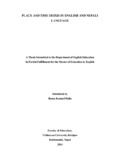Please use this identifier to cite or link to this item:
https://elibrary.tucl.edu.np/handle/123456789/1853| Title: | Place and Time Deixis in English and Nepalilanguage |
| Authors: | Malla, Rama Kumari |
| Keywords: | Nepali language;Time Deixis |
| Issue Date: | 2014 |
| Publisher: | Faculty of Education |
| Abstract: | This study‘Place and Time deixis in English and Nepali languageaimed toidentify and compare place and time deixis in English and Nepali language. Forthis study, I took sample population consisting of 60 Nepali speakers fromKathmandu valley.The sample was selected by using snowball samplingmethod.The study was basedon both primary and secondary data. Thequestionnaire schedule was distributed totheeducated informants to attendrequired information which served as primary data. However, the secondarysources were also used for collecting data for place and timedeixis. Theresponses given by the informants were coded for analysis and interpretation.On the basis of analysis and interpretation, I came to the conclusion thatEnglishplacedeictic expressionis richer than Nepali as there are differentterms to refer to the same term in the Nepali language.Regarding the presenttime deixis, English is richer than Nepali because different terms in English arerepresented by the same term in Nepali.Time deictic expressions in Nepali canbe classified on the basis oftense system, proximal and distal,and pure andimpure distinction.The expressions which point to the object near speaker areproximal deixis, those which point to the object away from speaker are distaldeixis and those which point to the object out of reach of speaker are calledneutral deixis.The deictic expression made up of a single word is pure and thedeictic expression made up of more than one word is an impure one.If thedeictic expressions are used for visible location those can be expressed usinggesture. But the expressions that are used for non-visible location cannot beexpressed through gesture.Likewise,Nepali place deictic expressions can beclassified as proximal, distal and neutral on the basis of time, pure and impureon the basis of marker, and gestural and non-gestural on the basis of context. The study is divided into five chapters. Chapter one is an introductory part. Itincludes background of the study, statement of the problem, rational of thestudy, objectives of the study, research questions or hypothesis, significance ofthe study, delimitation of the study and operational definitions of the key terms. ix Chapter two deals with review of the related literature and conceptualframework. Chapter three includes methods and procedures of the study underwhich research design, population and sample, sampling procedure, datacollection tools, data collection procedures, data analysis and interpretationprocedures are presented. Chapter four presents the results and discussion. Inthis section,both statistical as well as descriptive approaches are used. Chapterfive incorporates summary, conclusion and implications of the study.Thereferences and appendices form the concluding part of the thesis. |
| URI: | http://elibrary.tucl.edu.np/handle/123456789/1853 |
| Appears in Collections: | English Language Education |
Files in This Item:
| File | Description | Size | Format | |
|---|---|---|---|---|
| COVER.pdf | 35.71 kB | Adobe PDF |  View/Open | |
| CHAPTER.pdf | 187.99 kB | Adobe PDF |  View/Open |
Items in DSpace are protected by copyright, with all rights reserved, unless otherwise indicated.
